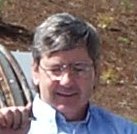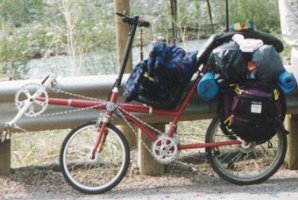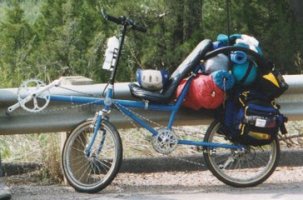#2 SWB Recumbent
|
This page describes my second SWB bicycle. It actually describes two bikes since I built one for myself and one for my wife, Denise. They differ in a few details but are basically of the same design.
The bikes described here are very similar to my previous SWB in both configuration and geometry. However many subtle changes have been incorporated for various reasons.
My first SWB was a great learning experience. It rode very nicely but there were several areas I wanted to improve. The major ones included:
- One of the goals of my first SWB was for it to collapse for transport on planes, trains and busses. During construction this feature was lost on my first bike. For my second this was a primary goal.
- The drive train on number one was custom made and involved much machining. I wanted to avoid this work on number two.
- Number one used narrow 451 20 inch tires. I wanted to be able to use either 451 rims or the wider and more robust 406 20 inch rims on number two.
- The seat on number one wasn't easily removable. This is a nice feature for transporting a SWB on a car top rack and I wanted to have this on number two.
I accomplished the goals set out above. The pictures above shown our bikes loaded and on tour in Montana.
Both bikes are fillet brazed from straight gage 4130 tubing. Figure 1 shows the bare frame. The forks are built from round track forks mainly to allow for the split collar fork crown. As with my first SWB, the fork blades are removable as part of the bikes collapsibility. The rear chain stays are built from unicrown fork blades. The boom is adjustable, a nylon bushing is clamped between the boom and main frame tube via a seat clamp bolt.
I had rear suspension on my first bike which has been lost on this second. Not that the rear suspension wasn't nice but it complicates the collapsibility.
Figure 2 shows the pieces of the frame as it disassembles for travel. This figure is a little deceiving since it shows only the frame without bicycle components, seat, handle bars or wheels. It does however show clearly how the frame breaks down. Seat clamp bolts hold several of the joints together. The brake bosses can be seen in Figure 2. Two sets were brazed in place, one for 451 rims and lower set for 406 rims.
Figure 3 shows the frame with cranks and wheels installed. The crank arrangement is a standard tandem set with the front chain on the left side and the rear chain on the right. I planned to cut off the stoker crank arms but hated to ruin these. I finally found some bent up cranks which I machined the arms from instead. Figure 3 shows the set up before these arms where machined away. The use of tandem cranks rather than custom machined drive components speeded construction.
The seat can be seen in Figure 3 but the mounting hardware is missing. The seat is a fiberglass (well really kevlar/carbon fiber) and purchased from Easy Racers. It is mounted with two quick release skewers and takes some 20 seconds to put on or remove, very handy.
Denise's bike is very similar. The major difference is in the use of a 17 inch Moulton wheel on the front. This lowers the seat substantially from using a 20 inch wheel. This difference can be seen in the two pictures above.
Table I gives the specifications for the bikes.A few problems have cropped up but not too many.
The nylon bushing between the boom and main tube was used to prevent the clamping from marring the power coat on the boom. This joint tends to slip even if well tightened.
For some reason the front shifter on my bike didn't work well. Denise's works much better but for some reason mine didn't. It must be due to a difference in angles somewhere. I finally removed the front deraileur and now shift the front chain rings with my finger. Not optimum but it's right under the seat and not far to reach.
Not a problem but something to note. I haven't used 451 rims on this bike. The 406 rims and tires seem to roll about as well and are less prone to punctures. I doubt that I'll ever use the 451 brake bosses.
We have had problems with punctures and blow outs with the 17 inch front tire on Denise's bike. I doubt that the lower seat height is worth the problems.
All in all very few problems. They have both been good bikes and an improvement on previous designs.
These bikes have served us very well. We've taken a few long tours with them and haven't been let down. On a tour from Spokane, WA to Toledo, OH we collapsed them for the Amtrak ride across North Dakota which worked very well.
Good bikes for touring.


